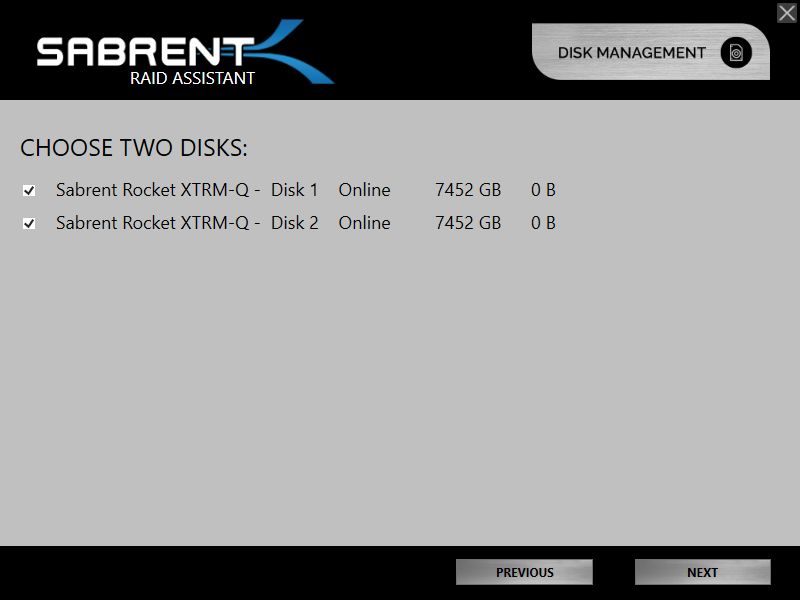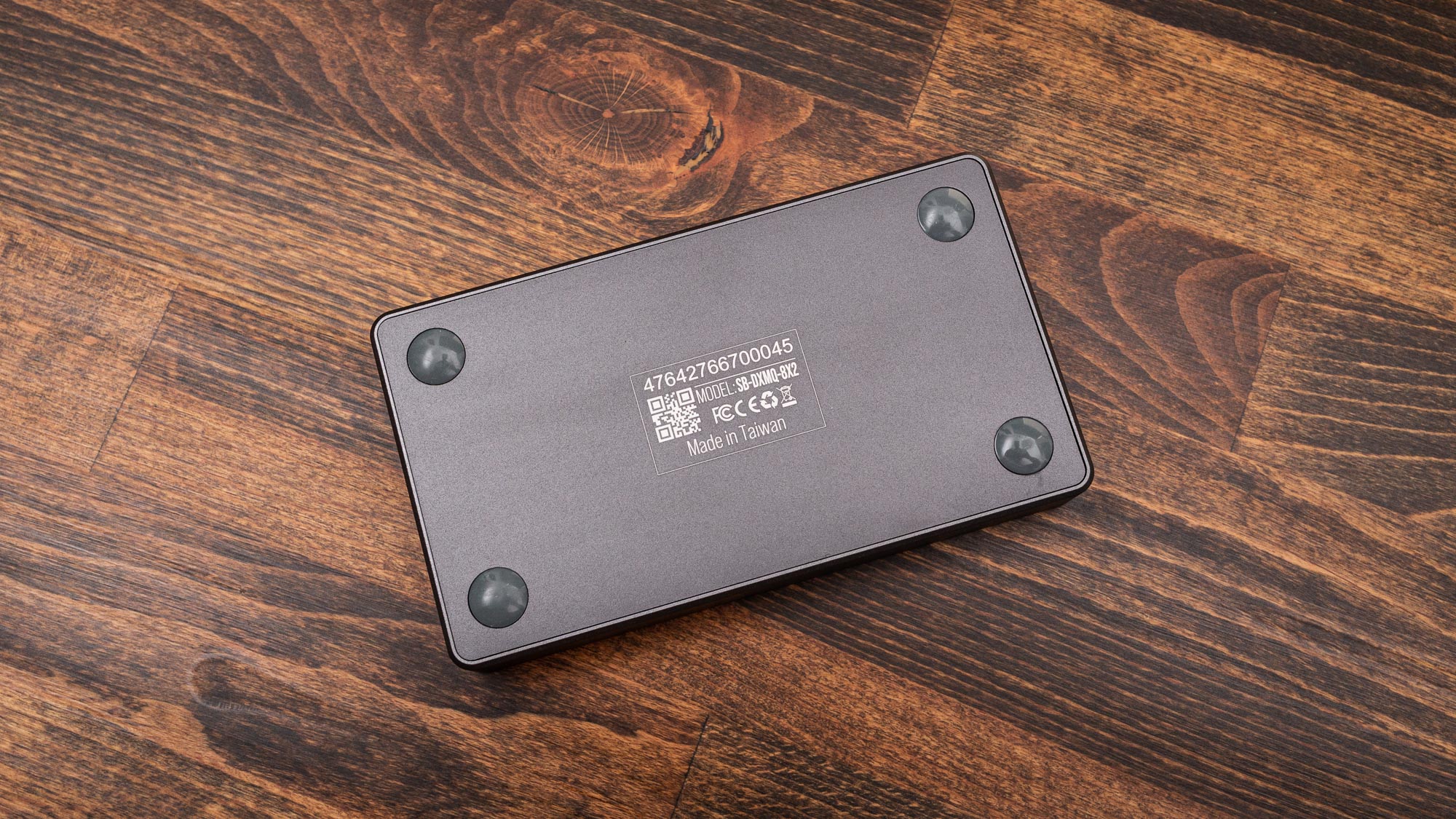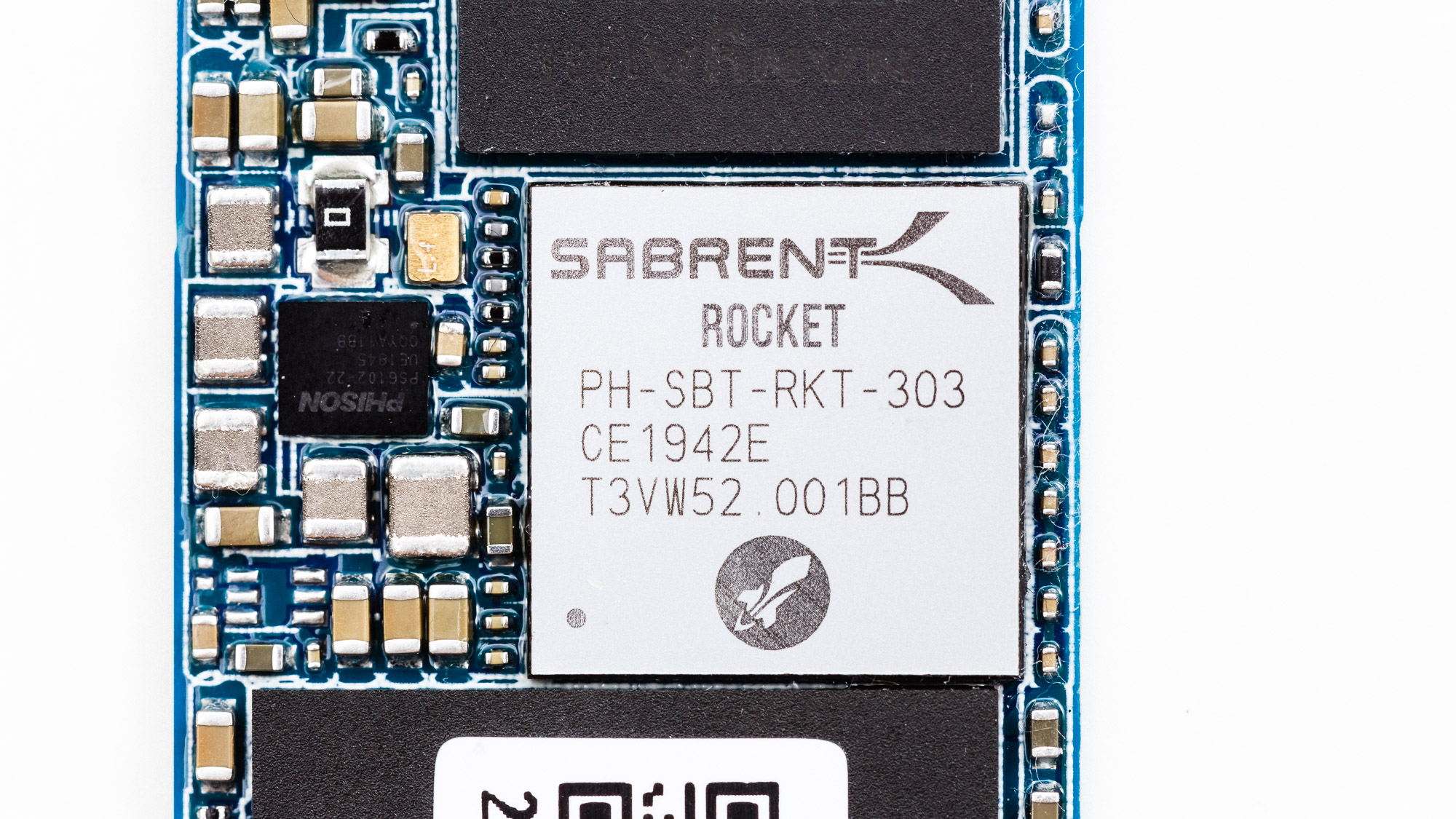Tom's Hardware Verdict
Sabrent’s 16TB Rocket XTRM-Q delivers massive storage capacity in a compact and power-efficient form factor. With up to 2.8GBps over its Thunderbolt 3 interface and RAID capability, it’s not only spacious but very fast and flexible, too.
Pros
- +
+ Highest-capacity Thunderbolt 3 SSD
- +
+ Sleek and compact
- +
+ Competitive performance
- +
+ Lengthy included Thunderbolt 3 cable
Cons
- -
Short 3-year warranty for the price
- -
Slow write speed after write cache fills
- -
Runs warm, but within spec
- -
No USB support
Why you can trust Tom's Hardware
Sabrent has pushed the boundaries of fast flash and high capacity with its recent SSDs, even more so than the biggest names in the industry. We thought that 8TB of flash storage was niche and extreme enough for most prosumers and enthusiasts when we first reviewed Sabrent’s 8TB Rocket XTRM-Q, but now the company is doubling down and pushing capacity to new limits with its 16TB model.
The new variant doubles capacity to 16TB, but it isn’t quite as portable as the 8TB model due to its larger form factor and power requirements. While the original XTRM-Q contained one Rocket Q M.2 NVMe SSD within, the new 16TB model has two of them behind a slightly different Thunderbolt 3 bridge, providing a ton of fast flash storage and potentially bus-saturating performance for those who need it. However, it comes at a high cost, tipping the scales at roughly $3,000, making it even more of a niche buy for those who can afford it.
Specifications
| Product | 16TB |
|---|---|
| Pricing | $2,899.99 |
| Capacity (User / Raw) | 16000 / 16384 |
| Interface / Protocol | USB-C / Thunderbolt 3 |
| Included | USB Type-C Cable and Power Brick |
| Sequential Read | RAID 0 - 2,800 MBps; JBOD - 1,400 MBps |
| Sequential Write | N/A |
| Interface Controller | Intel JHL6340 |
| NAND Controller | Phison E12S |
| DRAM | DDR3L |
| Storage Media | Micron 96L QLC |
| Default File System | exFAT |
| Power | Power Brick |
| Security | N/A |
| Dimensions (L x W x H) | 115 x 65 x 16 mm |
| Weight | 233 g |
| Part Number | SB-DXMQ-8X2 |
| Warranty | 3-Years |
Sabrent’s 16TB XTRM-Q offers up sequential read performance of up to 1.4 GBps or 2.8 GBps over Thunderbolt 3, depending on how you configure the device. It lacks an official sequential write performance rating, but based on our testing, it provides the same performance during write workloads as during reading tasks. It can be configured in RAID 0, RAID 1, or as JBOD to tailor the drive for performance, data reliability, or flexibility, respectively.
Priced at $2,899.99, the XTRM-Q isn’t cheap, and the warranty is lacking. It comes backed by a three-year warranty, which is short for a product of this capacity and price point. It’s noteworthy that the three-year warranty is longer than Sabrent’s standard one-year warranty. The SSD also lacks an endurance rating, just like most portable SSDs, but don’t expect Optane-like endurance. Each SSD within is likely limited to a similar amount of endurance as the Rocket Q drives under the hood.
Software and Accessories
The 16TB Rocket XTRM-Q comes with a long 28” USB-C Thunderbolt 3 cable and a power brick to power the unit. The power brick is not optional — the device will not power on without it. Our sample also came with a vented silicone sleeve for drop protection. In addition, the company provides Sabrent’s RAID assistant software, enabling quick and easy configuration in RAID 0, RAID1, or JBOD setups.







A Closer Look


The 16TB Rocket XTRM-Q measures 115 x 65 x 16 mm and weighs in at 233 grams. Given its capacity, it's a small and compact storage device. It is much smaller than the LaCie 2big RAID 16TB we reviewed in 2019, but not even twice as large as the portable 8TB Rocket XTRM-Q.
The exterior is made of solid aluminum, leading to a quality feel in your hands. It also comes with rubber feet to prevent sliding around wherever you may place it. There are two power/activity indicator lights to the left of the Thunderbolt 3 port, and the DC-in is to the right, along with a power button.
Get Tom's Hardware's best news and in-depth reviews, straight to your inbox.


Sabrent’s Rocket XTRM-Q is fully Thunderbolt certified by Intel. Internally, it is powered by an Intel JHL6340 Thunderbolt 3 controller with two PCIe 3.0 lanes allocated to each of the SSDs. The drives support Trim and S.M.A.R.T. data reporting, but as an Alpine Ridge-based controller, the drive is only compatible with Thunderbolt 3 and will not work when plugged into a standard USB C port. That’s similar to what we’ve seen with some Titan Ridge-powered Thunderbolt 3 devices.
Furthermore, RAID functionality is not built-in via a hardware controller; rather, the SSD uses software RAID functionality built into Windows or macOS.


As mentioned earlier, the XTRM-Q is powered by two 8TB Rocket Q M.2 NVMe SSDs. Each has a Phison E12S NVMe SSD controller and a DDR3L DRAM cache paired with eight NAND packages of Micron’s 1Tb 96L QLC flash. Additionally, each quad-plane die provides better interleaving capability (and thus performance) than the dual-plane designs found in competing flash. That’s especially important when considering the normally slow program times of QLC.
The controller operates at 666 MHz, but the flash interfaces with the controller at slower speeds than the retail Rocket Q we previously reviewed. Instead of interfacing at 666 MTps, these models operate at 333 MTps to control heat, but fortunately, this is more than enough to maintain responsive performance for its intended external application.
MORE: Best SSDs
MORE: How We Test HDDs And SSDs
MORE: All SSD Content

Sean is a Contributing Editor at Tom’s Hardware US, covering storage hardware.
-
kyzarvs Does the warranty become longer if you register the device on Sabrent's website? I've done that with both of my Rockets to change the warranty from one to five years (I think, been a few months since I did it).Reply -
PicoPete Thunderbolt or not, almost $3,000 for a plain-old-hard-drive is outrageous, regardless of its capacity. If you need or want something that large you can spend less than 1/5 the Sabrent price with the Western Digital...Reply
WD 18TB My Book Desktop External Hard Drive, USB 3.0 - WDBBGB0180HBK-NESN which has 2 TB's more capacity to boot (no pun intended) than the Sabrent, available on Amazon for $ 507.73 with a similar 3-year warranty. But it's your money, so spend it how you like! -
seanwebster Reply
No, unfortunately I was told that this product only gets a flat 3-yr warranty.kyzarvs said:Does the warranty become longer if you register the device on Sabrent's website? I've done that with both of my Rockets to change the warranty from one to five years (I think, been a few months since I did it).
Yes, that is entirely true, but it also performs at 1/10-1/20th the speed. This SSD is not meant for those who can deal with ultra-slow HDD speeds.PicoPete said:Thunderbolt or not, almost $3,000 for a plain-old-hard-drive is outrageous, regardless of its capacity. If you need or want something that large you can spend less than 1/5 the Sabrent price with the Western Digital...
WD 18TB My Book Desktop External Hard Drive, USB 3.0 - WDBBGB0180HBK-NESN which has 2 TB's more capacity to boot (no pun intended) than the Sabrent, available on Amazon for $ 507.73 with a similar 3-year warranty. But it's your money, so spend it how you like! -
PicoPete Reply
And just what are "users like you" please?Mandark said:It’s not targeted at users like you -
PicoPete Reply
Yes, I understand that. For certain users that require the speed, Thunderbolt is of course one option (especially in the closed ecosystem of Apple). My point is this: For the price of the Sabrent 16 TB drive I can put together a NAS with both an Ethernet and a USB option and top the 16 TB and also the speed. I myself have 3 NAS systems I've designed and one of them (the smallest) with 36 TB (Raid 5) with fiber-channel (10 GB/s bandwidth) connectivity that cost me approximately a couple hundred dollars less (as of 5 years ago) than the single-disk Sabrent 16TB offering. So my point is that it's a poor price/performance option for its capacity IMO, especially if it's used for long-term storage. I can see it used for for real-time video editing of 4K or 8K but even for that most editing is done in-memory on workstations with at least 64G RAM. But I can see the attraction for certain users that have deep pockets and want to spend the money, but it's still overpriced IMO.seanwebster said:No, unfortunately I was told that this product only gets a flat 3-yr warranty.
Thanks for your comment: Yes, that is entirely true, but it also performs at 1/10-1/20th the speed. This SSD is not meant for those who can deal with ultra-slow HDD speeds. -
USAFRet Reply
It's not "overpriced" if you need that performance right now.PicoPete said:Yes, I understand that. For certain users that require the speed, Thunderbolt is of course one option (especially in the closed ecosystem of Apple). My point it this: For the price of the Sabrent 16 TB drive I can put together a NAS with both an Ethernet and a USB option and top the 16 TB and also the speed. I myself have 3 NAS systems I've designed and one of them (the smallest) with 36 TB (Raid 5) with fiber-channel (10 GB/s bandwidth) connectivity that cost me approximately a couple hundred dollars less (as of 5 years ago) than the single-disk Sabrent 16TB offering. So my point is not that it's a poor price/performance option for its capacity IMO, especially if it's used for long-term storage. I can see it used for for real-time video editing of 4K or 8K but even for that most editing is done in-memory on workstations with at least 64G RAM. But I can see the attraction for certain users that hace deep pockets and want to spend the money, but it's still overpriced IMO.
SSD prices were over $1/GB not that long ago.
They did, and will continue to, drop.
And size will continue to increase. -
Reply
It was targeted at people who need extremely high speeds and work with very large files hence the thunderbolt three and hence the reason I say it’s not made for you because you’re complaining about the price. If you need it for business you wouldn’t be complainingPicoPete said:And just what are "users like you" please?
Is everything supposed to be free because you don’t like paying high prices?? Get real
